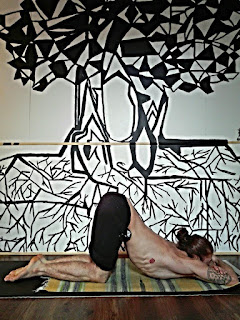The Anahatasana family, translated as the yoga puppy pose is my favorite activation before any deeper backbend, because it's completely focused on mobilizing the upper back area, by streaching the muscles of the front side of the body (anterior). The agonist/antagonist biomechanical relationship of the body provides this effect. While the agonist muscles contract to decrease the angle of the joint, in the same time, on the other side of the joint, the antagonist muscle streches to increase the angle. With Anahatasana, you engage the anterior portion of the deltoid and the upper third of the trapezeus muscle with moving the chest forward and in the same time, pushing back from the arms, into the direction of the shoulders. Like this, you lenghten the latissimus dorsi and the pectoralis major muscles.
A basic, positive effect of the backbend practice, that it's lenghtening the muscles of the front side of the body, like the abdomins and the serratus anterior etc., so making possible to increase the lungh capacity with expanding the space of the chest. The name, yoga puppy is kind of misleading, because the sanskrit Anahata word refers to the heart. It means unbeaten, unstruck, unwounded, intact, new and unbleached ect. So it refers to the hearts purity, therefore in the yoga terminology, sometimes we call the backbends heart opening asanas. Heart opening is the psychological effect, which the expanded chest causes, by making our lung capacity better. So you will breath more freely, therefore you will feel more freely. The positive sensation caused by expanding the chest is a natural motion driven feeling in everyones life. We all know how good to leave a building for example and arch with the upper back and breath in deeply the fresh morning air. With the Anahatasana you are strongly focusing to this area, so you can learn the proper muscle isolation of the upper back really quickly. So you will learn how to move from the upper back, how to decrease and increase the joint maximaly with using the proper movement and proper activation.
1. Anahatasana:
So the first variation, you see is without Padmasana. Lay on your stomach and put your crossed arms a little bit under your chest. Grab the upper third of your lower arm and move backward with the sitting bones into kneeling position. From here, push back from your elbows into the direction of the shoulders and in the same time, move your chest forward, into the direction of your yoga mat. The goal is to put your chest and chin down and be in the position quite comfortable. Move your abdominal muscles into the direction of your quadriceps, push backward with the sitting bones, but keep continue to push the chest forward and into the direction of the yoga mat. Keep active your abdominal muscles and the gluteal all the time to protect your lower back from hyper extension and transfer the pressure into the center of your chest. Sink between your shoulders, feel that your deltoid releases slowly and your chest is going closer and closer to the yoga mat. If your chest is on the floor, you can decrease the angle more, if you close your legs completely and walk closer with your knees. You can use the technique of the facilitated streach. When you feel, you reached your maximum, come back a bit, release the tention a bit, rest in the position, then go deeper.
When you reached your maximum like this, you can straighten your arms. Your chest and chin need to remain in the same position. The movement patterns are the same, but you are pushing backward from your palms, not from your elbows. Feel the different sensation in your shoulder and upper back.
If you also reached your maximum in this position, with active and strong abdomins and gluteal, with the chest and arms on the mat, you can lift up your gluteal, and begin to straighten your legs slowly, pushing forward, from the balls of the toes. In the same time, resist with your arms, pushing into the other direction with them, as a counter activation.
2. Anahatasana with Padmasana:
The lotus variations have the same activation and movement patterns, like the Anahatasana without lotus. But the difference is that you are also working on the hip rotators very intensively. I will write a lot about hip rotation later (how to unlock your hips in a healthy way), but in this post safety is the most important part, if you wanna do the Padmasana version of the Anahatasana. Firstly and most importantly, protect your knees, because in this asana varaiation, your knees carry an important amount of your weight. Use pillows or a thicker yoga mat. Do a deep lotus, putting your feet high on your thighs, using your hip flexors for the asana, not your ankle and knee. It means, you have to use your proprioceptive skills and feel the tention in the muscles of your hip and gluteus not on the outer part of your knees, or inside your ankles. In this variation, after you kneel up from lotus, you have to measure the angle you can bend with your back, because after your chin and chest is on the floor or moving into the direction of the floor, you can't change the position with 'walking' the knees closer, only if you sit up. Try to not overuse your knees, surely have a soft surface if you want to hold it longer and make the movement from your hip muscles and the backbend from your chest, and upper back.










Nincsenek megjegyzések:
Megjegyzés küldése